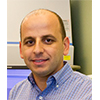Venue
Althanstrasse 14,
Building UZA II,
Lecture Hall 8,
1090 Vienna
For more Information about the Venue please click here.
Invited Speakers

Prof. Mohammed Baalousha
Associate Professor
Center for Environmental Nanoscience and Risk
Department of Environmental Health Sciences
Arnold School of Public Health

Prof. Anders Baun
Department of Environmental Engineering
Technical University of Denmark

Dr. Geert Cornelis
Department of Soil and Environment
Swedish University of Agricultural Sciences

Dr. Ralf Kaegi
Department Process Engineering
EAWAG - Swiss Federal Institute of Aquatic Science and Technology

Prof. Christine Hendren
Department of Civil and Environmental Engineering
Duke University

Prof. Jason Unrine
Department of Plant and Soil Sciences
University of Kentucky

Dr. Thorsten Hüffer
EDGE –Environmental Geosciences
Centre for Microbiology and Environmental Systems Science,
University of Vienna
Sunday, 1st September 2019
| 17:00 - 19:00 | Registration Entrance Hall | |
| 18:00 - 20:00 | ICEENN Ice Breaker - Get2gether Althanstrasse 14, 1090 Vienna, Building UZA II, Staircase D+E | |
Monday, 2nd September 2019
| 08:00 - 18:00 | Registration Entrance Hall | |
| 08:45 - 09:00 | Opening Ceremony Vice Rector Jean-Robert Tyran & DEGS Thilo Hofmann & Conf. Chair Frank v.d. Kammer | |
| Theme F: Modeling, Data Repositories and Nano-Informatics | Session Chairs: Mark Wiesner & Thilo Hofmann | |
| 09:00 - 09:30 | Christine Hendren | NanoEHS: A Case Study in Convergent Team Science through Harmonized Methods and Data Integration Projects |
| 09:30 - 09:45 | Joris Quik | Screening level multimedia fate model for engineered nanomaterials: SimpleBox4nano |
| 09:45 - 10:00 | Nico van den Brink | Modelling uptake kinetics of nanomaterials in invertebrate organisms |
| 10:00 - 10:15 | Astrid Manders | Modelling atmospheric fate of TiO2 and its impact on atmospheric chemistry |
| 10:15 - 10:30 | Lila Thornton | Estimation of Nanomaterial Weight Fraction in Consumer Products Using Machine Learning Methods |
| 10:30 - 10:45 | Jaleesia Amos | Applications of the NanoInformatics Knowledge Commons Toolkit |
| 10:45 - 11:30 | Coffee Break | |
| Theme D: Release, Behavior and Fate in the Environment (I) | Session Chairs: Mohammed Baalousha & Geert Cornelis | |
| 11:30 - 11:45 | Mark Wiesner | Nanomaterials : Not the next asbestos or What 20 years of nanomaterial implication research has taught us |
| 11:45 - 12:00 | Kamil Nešetřil | Laboratory and field strategy for renegade nZVI particles |
| 12:00 - 12:15 | Willie Peijnenburg | Modeling particle dissolution kinetics and resulting time-dependent suspension toxicity within a framework for grouping of nanomaterials |
| 12:15 - 12:30 | Sam Harrison | Predicting the environmental fate of engineered nanomaterials using a spatiotemporal multimedia fate model |
| 12:30 - 13:30 | Lunch Break | |
| 13:30 - 14:00 | Ralf Kaegi | The Quest of Engineered and Transformed Nanoparticles: Challenges, Limitations and Wishful Thinking |
| 14:00 - 14:15 | Bernd Nowack | Influence of the nanomaterial definition and material-specific properties on exposure and risk assessment of engineered nanomaterials |
| 14:15 - 14:30 | Veronique Adam | Integrated dynamic probabilistic model of engineered nanomaterial releases to the environment |
| 14:30 - 14:45 | Nathan Bossa | “Nano-TiO2 for indoor paint” caLIBRAte Case Study: generation of data along nanomaterial life cycle |
| 14:45 - 15:00 | Wei Chen | Crystallinity and Exposed Facets Significantly Affect Affinity and Reactivity of Metal-Based Nanocrystals towards Organic Contaminants and Biomolecules |
| 15:00 - 15:15 | Xiaoran Zhang | Sorption of Triclosan by Carbon Nanotubes: the Importance of Dispersing Properties Caused by Sonication, Functionalization, Solution Chemistry and Dispersants |
| 15:15 - 15:45 | Coffee Break | |
| 15:45 - 16:15 | Claus Svendsen | NanoFASE – the knowledge about “Nanomaterial Fate and Speciation in the Environment” that 65+ people developed and how we are sharing it. |
| 16:15 - 16:30 | Helene Walch | A tale of an engineered nanoparticle’s affection for natural suspended particulate matter in freshwaters |
| 16:30 - 16:45 | Serge Stoll | Determination of Nanoparticle Heteroaggregation Attachment Efficiencies and Kinetics Rates in Different Aquatic Environmental Matrices using Computer Modeling. A Multi-Component Approach including NPs, NOM and ICs. |
| 16:45 - 17:00 | Stephen Lofts | Environmental exposure modelling for nanomaterials: meeting EU research, regulatory, stakeholder and policymaker needs |
| 17:00 - 17:15 | Vicenç Pomar Portillo | Engineered Nanomaterials Release from Textiles: Three NanoFASE case studies |
| 17:15 - 18:30 | Poster Time & Social | |
Tuesday, 3rd September 2019
| 09:00 - 17:00 | Registration Entrance Hall | |
| Theme C: Analytical Methods and Instrumentation | Session Chairs: Ralf Kaegi & Armand Masion | |
| 09:00 - 09:30 | Mohammed Baalousha | Analysis of Engineered Nanoparticles in the Natural Environment |
| 09:30 - 09:45 | Narjes T. S. Khomami | Field deployable reactors for investigating the interaction of nanoparticles with natural organic matter under field conditions |
| 09:45 - 10:00 | Julian Gallego | Evaluation of heteroaggregation rates of CeO2 and Au NPs using dual-element single-particle ICPMS |
| 10:00 - 10:15 | Kaymar Mehrabi | Multiplexed Quantification of Metal-Containing Nanoparticles in Waste Water Treatment Plants across Switzerland by ICP-TOFMS |
| 10:15 - 10:30 | Madjid Hadioui | Detection and quantification of low concentrations of small nanoparticles in natural waters using high sensitivity single particle ICP-MS |
| 10:30 - 10: 45 | Andrew Chetwynd | Capillary Electrophoresis-Mass Spectrometry Characterisation: Protein & Metabolite Coronas |
| 10:45 - 11:30 | Coffee Break & Poster | |
| Theme B: Nano-Bio Interactions and Uptake | Session Chairs: Iseult Lynch & Jason Urine | |
| 11:30 - 11:45 | Marta Baccaro | Long term, chronic toxicokinetics of silver and silver sulphide nanoparticles in earthworms exposed for nine months |
| 11:45 - 12:00 | Xinyao Yang | Gram-negative Escherichia coli promotes deposition of polymer-capped silver nanoparticles in saturated porous media |
| 12:00 - 12:15 | Partricia Silva | Silver toxicokinetics in the freshwater snail Physa acuta exposed to pristine and aged silver nanoparticles under different exposure routes |
| 12:15 - 12:30 | Elma Lahive | The influence of the plant rhizosphere on the availability of silver nanoparticles to wheat exposed in soil |
| 12:30 - 13:30 | Lunch Break | |
| 13:30 - 14:00 | Anders Baun | In Search of the Nanoeffect – Seeing is Believing but (sometimes) Deceiving |
| 14:00 - 14:15 | Zahra Khodaparast | Ag2S-NP uptake in the mealworm Tenebrio molitor: validation of single species tests with indoor mesocosms experiments |
| 14:15 - 14:30 | Nathaniel Clark | The use of single particle ICP-MS to highlight species differences in gastrointestinal physiology: fish versus rodent |
| 14:30 - 14:45 | Richard Handy | A Tiered Dietary Bioaccumulation Testing Strategy For Engineered Nanomaterials Using Fish. |
| 14:45 - 15:00 | Fazel Abdolahpur Monikh | Systematic quantification of nanoparticles uptake in algae cells using single-cell inductively coupled plasma mass spectrometry: influence of size, shape and NOM corona |
| 15:00 - 15:15 | Becky Curtis | Determining the critical pathways involved in nano-bio interaction across species |
| 15:15 - 15:45 | Coffee Break | |
| Theme A: Ecotoxicology | Session Chairs: Anders Baun & Claus Svendsen | |
| 15:45 - 16:00 | Michael Burkard | Copper nanoparticles impair the mechano-sensory based behavior of larval zebrafish (D. rerio) |
| 16:00 - 16:15 | Armand Masion | Mesocosm Testing: A Potential Standard for Non-Occupational and Exposure Driven Risk Assessment of Engineered Nanomaterials |
| 16:15 - 16:30 | Joel Gauthier | Selected Considerations Towards Canada’s Approach for Ecological Risk Assessment of Manufactured Nanomaterials |
| 16:30 - 16:45 | Roberto Martins | Environmental risk assessment of a novel anti-corrosion engineered nanomaterial |
| 16:45- 17:00 | Wilson Engelmann | Precautionary measures and anticipatory governance for nanotechnological risk management |
| 19:00 - 23:00 | DINNER | Vienna City Town Hall Lichtenfelsgasse 2, 1010 Vienna |
Wednesday, 4th September 2019
| 08:00 - 12:00 | Registration Entrance Hall | |
| Theme G: Nanoplastics in the Aquatic Environment | Session Chairs: Thilo Hofmann & Richard Handy | |
| 09:00 - 09:30 | Thorsten Hüffner | Are We Speaking the Same Language? Recommendations for a Definition and Categorization Framework for Plastic Debris |
| 09:30 - 09:45 | Gopala Krishna Darbha | Understanding the stability and deposition behaviour of nanoplastics at rock and mineral surfaces |
| 09:45 - 10:00 | Joana C. Prata | Where are the microplastics? Improving identification by natural organic matter removal, staining with Nile Red and using an automated software |
| 10:00 - 10:15 | Richard Cross | Detection of microplastics in the water treatment process: A discussion of sampling, processing and analytical methods for the detection of microplastics in increasingly complex media |
| 10:15 - 10:30 | Magdalena Dinkel | Field-Flow Fractionation coupled online to Raman Microspectroscopy for the analysis of submicroplastic particles |
| 10:30 - 11:00 | Coffee Break | |
| Theme E: Applications in the environment | Session Chairs: Christine Hendren & Thorsten Hüffer | |
| 11:00 - 11:30 | Jason Unrine | Developing nanocarriers for delivery of double stranded RNA as a biological pest control agent |
| 11:30 - 11:45 | Jamie Lead | The development of a nanotechnology-based oil remediation scheme. |
| 11:45 - 12:00 | Fabienne Schwab | Proof of Concept of a Nanosilica Agrochemical |
| 12:00 - 12:15 | Gopala Krishna Darbha | Synthesis and application of clay supported amorphous aluminum nanocomposite for the removal of hexa-valent Chromium from aqueous solutions |
| 12:15 - 13:15 | Lunch Break | |
| Theme D: Release, Behavior and Fate in the Environment (II) | Session Chairs: Jamie Lead & Stephen Lofts | |
| 13:15 - 13:45 | Geert Cornelis | An evaluation of current nanomaterial fate predictions in soils |
| 13:45 - 14:00 | Sónia Rodrigues | Adaptation of ORCHESTRA to predict temporal changes in bioavailable metal concentrations in soils amended with dissolving metal-based nanoparticles |
| 14:00 - 14:15 | Derek Peloquin | Metals Composition and Concentration in Aerosols (Incidental Nanoparticles) Released During Use of 3D Printing Toy Pens and Printer |
| 14:15 - 14:30 | Jonas Wielinski | In-situ mobilization of (transformed) Ag, Au and Ce nanoparticle(s) from sewage sludge ash |
| 14:30 - 14:45 | Elena Badetti | Assessment of nano-TiO2 colloidal stability in environmental media by analytical techniques and principal component analysis |
| 14:45 - 15:00 | Garret Bland | Developing a machine learning model to identify titanium dioxide engineered nanoparticles in soil matrices by spICP-TOFMS |
| 15:00 | Closing & Farewell | |
